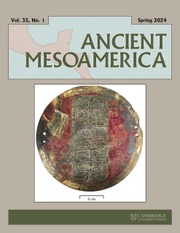Crossref Citations
This article has been cited by the following publications. This list is generated based on data provided by
Crossref.
Webster, David
Fash, Barbara
Widmer, Randolph
and
Zeleznik, Scott
1998.
The Skyband Group: Investigation of a Classic Maya Elite Residential Complex at Copán, Honduras.
Journal of Field Archaeology,
Vol. 25,
Issue. 3,
p.
319.
Lucero, Lisa J.
1999.
Classic Lowland Maya Political Organization: A Review.
Journal of World Prehistory,
Vol. 13,
Issue. 2,
p.
211.
Webster, David
1999.
The archaeology of Copán, Honduras.
Journal of Archaeological Research,
Vol. 7,
Issue. 1,
p.
1.
Powis, Terry G.
Stanchly, Norbert
White, Christine D.
Healy, Paul F.
Awe, Jaime J.
and
Longstaffe, Fred
1999.
A reconstruction of Middle Preclassic Maya subsistence economy at Cahal Pech, Belize.
Antiquity,
Vol. 73,
Issue. 280,
p.
364.
Webster, David
1999.
The Archaeology of Copán, Honduras.
Journal of Archaeological Research,
Vol. 7,
Issue. 1,
p.
1.
Parnell, J. Jacob
Terry, Richard E.
and
Sheets, Payson
2002.
Soil Chemical Analysis of Ancient Activities in Cerén, El Salvador: A Case Study of a Rapidly Abandoned Site.
Latin American Antiquity,
Vol. 13,
Issue. 3,
p.
331.
Marcus, Joyce
2003.
Recent Advances in Maya Archaeology.
Journal of Archaeological Research,
Vol. 11,
Issue. 2,
p.
71.
Robin, Cynthia
2003.
New Directions in Classic Maya Household Archaeology.
Journal of Archaeological Research,
Vol. 11,
Issue. 4,
p.
307.
Wendt, Carl J.
2005.
Using Refuse Disposal Patterns to Infer Olmec Site Structure in the San Lorenzo Region, Veracruz, Mexico.
Latin American Antiquity,
Vol. 16,
Issue. 4,
p.
449.
Smith, Michael E.
and
Schreiber, Katharina J.
2005.
New World States and Empires: Economic and Social Organization.
Journal of Archaeological Research,
Vol. 13,
Issue. 3,
p.
189.
Stockett, Miranda K.
2005.
Approaching Social Practice through Access Analysis at Las Canoas, Honduras.
Latin American Antiquity,
Vol. 16,
Issue. 4,
p.
385.
Hutson, Scott R.
and
Terry, Richard E.
2006.
Recovering social and cultural dynamics from plaster floors: chemical analyses at ancient Chunchucmil, Yucatan, Mexico.
Journal of Archaeological Science,
Vol. 33,
Issue. 3,
p.
391.
Hutson, Scott R.
Stanton, Travis W.
Magnoni, Aline
Terry, Richard
and
Craner, Jason
2007.
Beyond the buildings: Formation processes of ancient Maya houselots and methods for the study of non-architectural space.
Journal of Anthropological Archaeology,
Vol. 26,
Issue. 3,
p.
442.
Masson, Marilyn A.
and
Freidel, David A.
2012.
An argument for Classic era Maya market exchange.
Journal of Anthropological Archaeology,
Vol. 31,
Issue. 4,
p.
455.
Hirth, Kenneth
2013.
Economic Consumption and Domestic Economy in Cholula's Rural Hinterland, Mexico.
Latin American Antiquity,
Vol. 24,
Issue. 2,
p.
123.
Fowler, William R.
Cynthia, Robin
and
Scott, Hutson
2014.
INTRODUCTION.
Ancient Mesoamerica,
Vol. 25,
Issue. 2,
p.
367.
Farahani, Alan
Chiou, Katherine L.
Cuthrell, Rob Q.
Harkey, Anna
Morell-Hart, Shanti
Hastorf, Christine A.
and
Sheets, Payson D.
2017.
Social Perspectives on Ancient Lives from Paleoethnobotanical Data.
p.
101.
Kowalewski, Stephen A.
and
Heredia Espinoza, Verenice Y.
2020.
The Evolution of Social Institutions.
p.
495.
Herrera-Parra, Esteban Moisés
2021.
Actividades que dejan huella. Un estudio arqueológico de suelos de ocupación en Sihó, Yucatán.
Anales de Antropología,
Vol. 55,
Issue. 1,
p.
143.

